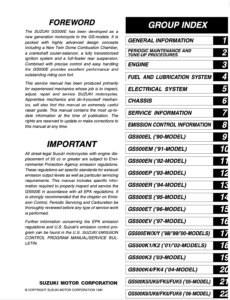Complete PDF version of the Service Manual for the Suzuki GS500E. A MUST for every GS500E owner.
Download: Immediately after payment!
OEM Original factory workshop manual.
Models covered by this manual: 1989 to 2006
Number of pages: 440 pages
Table of contents:

This PDF repair manual can be downloaded right after the payment process in complete, on the device of your choice. You will also receive the download link by email along with your receipt.
We do not offer printed manuals, for the following reasons:
- it is more eco-friendly to use a digital version
- your manual never gets dirty or greasy
- you can always choose to print the specific page(s) you need to work on your bike
- you receive your manual immediately after payment
- it is searchable

Suzuki GS500/E
Suzuki Motor Corporation manufactures and markets the Suzuki GS500, an entry-level motorbike.
Suzuki manufactured the GS500 and GS500E models beginning in 1989 and the completely faired GS500F variant beginning in 2004. South America is actively producing and selling the GS500. The GS500 has been hailed as a best purchase and an outstanding starting bike, with enough if not thrilling power for more experienced riders (approximately 40 HP at the rear wheel).
The unfaired GS500 was originally marketed in the United Kingdom in 1988 (model code GS500EJ), and the next year’s variant (code GS500EK) was available for sale in Europe and North America. It had an air-cooled parallel twin-cylinder engine adapted from the previous GS450. For more than two decades, the GS500 constituted the bottom end of Suzuki’s mid-sized range.
Suzuki also produced GS500 models with engines restricted to meet the maximum power-to-weight ratio for use in countries with restrictive motorcycle licenses (the GS500 meets current EU and UK licence level A2 conditions without restricting the engine) or for countries with a Learner Approved Motorcycle program (such as Australia and New Zealand).
The engineering pedigree of the GS500 may be traced back to Suzuki’s first contemporary 4-stroke bikes. Suzuki began producing 4-stroke engines with the 1976 introduction of the GS750 air-cooled inline-four and the GS400 parallel-twin, after previously producing solely 2-stroke engines for 20 years.
The Suzuki GS line quickly grew to include bigger and smaller four-cylinder bikes, the GS1000 and GS550, respectively, while the twin-cylinder engine was bored out to become the GS425 twin. All of these versions used the original GS engine configuration, which had double overhead cams, two shim-adjusted valves per cylinder, and a roller-bearing crankshaft.
Inline four GS500E 1979-1982
In 1979, the GS500E motorcycle debuted, powered by a sleeved-down version of the GS550 engine (with smaller carburetors). The GS500E four was designed for markets where the reduced displacement met insurance or licensing requirements.
Parallel twin GS500E 1988-2000
Suzuki changed the basic GS series engine architecture to create the GS450 twin, a successor to the GS425, with a redesigned bottom-end design that featured a one-piece 180° crankshaft operating on simple bearings. Engine vibrations were managed by a balancing shaft. The displacement of this twin increased from 448 cubic centimetres (27.3 cu in) to 487 cubic centimetres (29.7 cu in) in 1988, when it became the engine for the new GS500E, thanks to a 3 mm bigger diameter.
Although the GS500E twin was based on an existing design, Suzuki created a whole new frame, running gear, and bodywork for the 1988 GS500EJ model geared at urban riders, beginning motorcyclists, and those on a budget. Furthermore, the GS500EJ debuted with Mikuni ‘Slingshot’ series carburetors, a design that was also employed on the Suzuki GSX-R750 racer-replica. Despite producing less horsepower than equivalent multivalve engines, the two-valve GS500 engine produced proportionately higher torque at low speeds.
The bike had a black painted engine installed on a light grey frame and white wheels when it was debuted in the UK in 1988, and the GS500EK model in Europe and North America in 1989. The early GS500 motorcycles had low two-piece handlebars that looked like clip-ons but were really fastened to the top triple tree. The handlebars were elevated to a more normal height in 1990. A California-specific variant for 1990 featured a lower fuel capacity of 15.0 liters (3.3 imp gal; 4.0 US gal) instead of 17 liters to make place for an evaporation canister under the tank.
The front suspension of the GS500EN (1992) was enhanced by adding spring preload adjustments to the forks. In 1996, the painted wheels were changed from white to dark grey, as was the frame on certain versions. The engine had been repainted black.
In 1997, new front brake calipers for the GS500EV were introduced, with two huge pistons replacing the previous unequally sized pistons. French versions were equipped with Mikuni BSR 34mm carburetors with a three-circuit configuration (pilot jet, mid-main jet, main jet) beginning in 1998 (GS500EW) for precise fuel metering throughout the rev range.
GS500 2001—2016
The GS500 received a new body and a 20-liter fuel tank in 2001. The rims of the wheels were painted light gray. Mikuni BSR 34mm carburetors, previously only seen on French cars, were made available to all markets. To minimize emissions, pulsed secondary air injection was employed.
In addition to deleting the GS500’s ‘E’ designation, all Suzuki bikes transitioned from a single letter code for the model year (e.g., ‘X’ for 1999) to a letter-and-number code: K1 for 2001, K2 for 2002, L0 for 2010, and so on. The wheel color was changed to black in 2002, and the frame was likewise painted black beginning in 2004.
Suzuki discontinued production of the GS500E for the US market in 2002 and did not introduce a GS500 for 2003. Suzuki discontinued the GS500 in the United Kingdom and Spain in 2007, however it was still marketed in other countries.
Suzuki Motor Corporation manufactures the GS500 at its Latin American manufacturing subsidiary Suzuki Motor de Colombia S.A. for sale in Colombia, export to Chile (where it is promoted as a vintage model), and Ecuador as of 2016.
Source: Wikipedia

